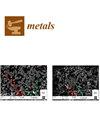通过分子动力学模拟研究铝板撞击诱发空化的图像方法
IF 2.5
3区 材料科学
Q3 MATERIALS SCIENCE, MULTIDISCIPLINARY
引用次数: 0
摘要
目标中两个反射波叠加产生的拉伸应力在解释平板冲击引起的剥落中起着关键作用。我们提出了一种图像方法来模拟波叠加的物理过程,并应用这种方法通过分子动力学模拟来研究单晶铝的空化机理。该方法得到的空化临界冲击载荷速度小至 400 m/s,远低于传统活塞载荷法得到的结果(650 m/s)。所发现的新空化机理与传统的高速冲击下位错-方差诱发的空化机理截然不同。新机制涉及两个关键事件:首先,在高拉伸应力作用下,裂纹状缺陷形成,其相关原子键断裂,导致相关原子产生巨大动量;其次,先前的高动量原子在运行过程中与原子发生碰撞,导致原有的 FCC 结构局部破坏,形成纳米空洞或笔形空洞。此外,空化区域、空洞数量和分层表面会随着冲击载荷速率的增加而增加。本文章由计算机程序翻译,如有差异,请以英文原文为准。
A Method of Images to Study Plate-Impact-Induced Cavitation in Aluminum through Molecular Dynamics Simulation
The tensile stress generated by the superposition of two reflection waves in the target plays a critical role in explaining plate-impact-induced spalling. A method of images is proposed to simulate the physical process of wave superposition and this method is applied in order to study the cavitation mechanism in single-crystal Al through molecular dynamics simulation. The critical impact-load velocity for the cavitation obtained by this method is as small as 400 m/s, which is much lower than the result (650 m/s) obtained by the conventional piston-load method. The new cavitation mechanism found is distinctively different from the conventional dislocation-entanglement-induced cavitation under high-velocity impact. The new mechanism involves two key events: firstly, a crack-like defect is formed and its relevant atomic bonds are broken under high tensile stress, resulting in a great momentum of related atoms; and secondly, previous high-momentum atoms collide with the atoms in their running way, resulting in the destruction of the original FCC structure locally and nanovoids or penny-shaped voids being formed. Additionally, the cavitation region, the number of voids, and delamination surfaces increases with the impact-load rate.
求助全文
通过发布文献求助,成功后即可免费获取论文全文。
去求助
来源期刊

Metals
MATERIALS SCIENCE, MULTIDISCIPLINARY-METALLURGY & METALLURGICAL ENGINEERING
CiteScore
4.90
自引率
13.80%
发文量
1832
审稿时长
1.5 months
期刊介绍:
Metals (ISSN 2075-4701) is an open access journal of related scientific research and technology development. It publishes reviews, regular research papers (articles) and short communications. Our aim is to encourage scientists to publish their experimental and theoretical results in as much detail as possible. Therefore, there is no restriction on the length of the papers. The full experimental details must be provided so that the results can be reproduced. Metals provides a forum for publishing papers which advance the in-depth understanding of the relationship between the structure, the properties or the functions of all kinds of metals.
 求助内容:
求助内容: 应助结果提醒方式:
应助结果提醒方式:


